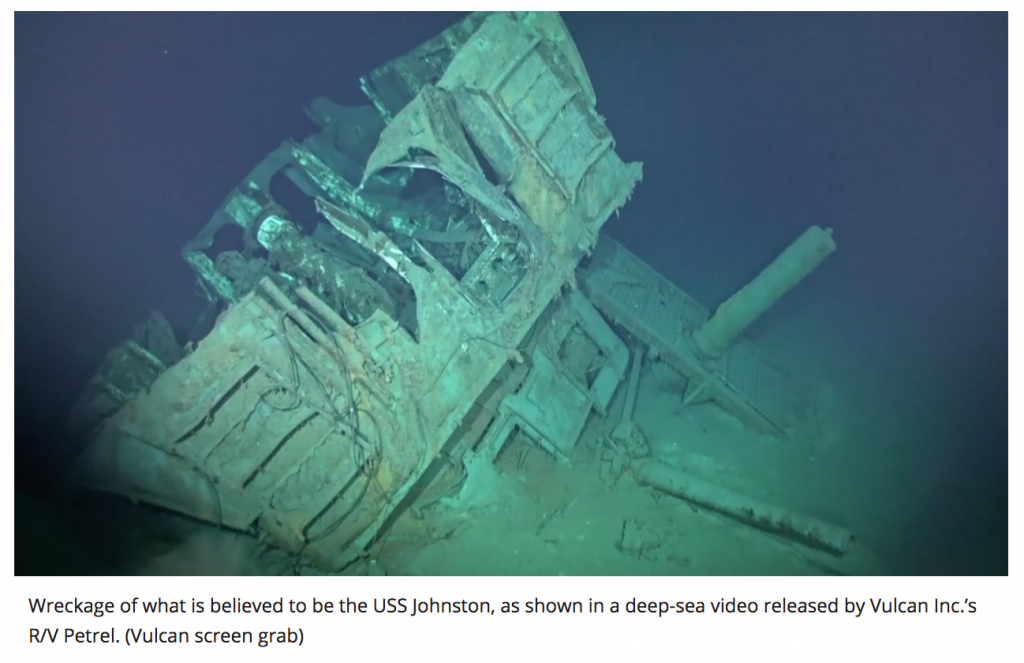Allen’s Research Vessel Discovers WWII Battleship in Deepest Water
In the past four decades or so, the biggest discoveries have not been Lewis and Clark expeditions or comparable to Magellan sailing around the world. Mapping the human genome and cyber advances, however, have opened up new frontiers in thought.
The late Paul Allen, co-founder of Microsoft, however, left a legacy that has led to one of the most stunning adventures in recent underwater exploration.
Allen, who established the Allen Institute for Artificial Intelligence in 2013, was also involved in deep-sea exploration, and he led expeditions that discovered the wrecks of various World War II vessels, notably the USS Indianapolis (2017) and the USS Lexington (2018).
The private company was started by Allen and his sister, Jody Allen, to handle the family’s business and philanthropy activities, including underwater research. The Allen’s research vessel discovered the deepest sunken ship ever in the Philippine Sea, according to Geekwire.com. Yes, ever.
Vulcan Inc. released footage Wednesday of the deepest shipwreck ever discovered, the scattered remains of the USS Johnston. The World War II Fletcher class destroyer that lies 20,400 feet (6,220 meters) below the surface on the edge of the Emden Deep in the Philippine Sea. For Americans who feel confused with metric stats, that’s around 5 miles down.
The ship was lost during the Battle of Leyte Gulf off Samar, one of four battles that occurred on Oct. 25, 1944.
“We believe this wreck to be that of the USS Johnston DD-557,” said Robert Kraft, director of subsea operations for Allen’s Vulcan Inc. “There is no evidence of the dazzle paint scheme, indicative of the USS Hoel and its location suggests this wreck sank later in the battle, after the loss of the Hoel.”
The battle was a “mismatch,” according to a story in The New York Times, which said the small unit of U.S. Navy ships was attacked by a “mighty squadron of Japanese warships.” The losses included two escort carriers, two destroyers, one destroyer escort and 23 aircraft. Japanese forces lost three heavy cruisers and 52 aircraft during the conflict, according to a Vulcan news release.
The Johnston wreckage is at a depth just below the operational limit of the remotely operated vehicle sent down by the Petrel.
“During this dive, our deepest yet, we encountered challenges that impacted our ability to operate and obtain the typical, high quality survey that we strive for,” said Mayer, who is also a Petrel ROV pilot.
A Smithsonian.com story said that archeologists confirmed the Fletcher-class destroyer, but the debris may be that of the U.S.S. Hoel DD-533, another destroyer sunk at Samar. The discovery came just over a week after the Petrel located other significant WWII shipwrecks. The Japanese aircraft carriers IJN Kaga and Akagi, both lost during the Battle of Midway in 1942, were discovered.
“Robert Neyland, head of the NHHC’s Underwater Archaeology Branch, tells USNI News’ Ben Werner the damage is so extensive that no easy identifiers—think the number 557 on the hull or the ship’s name etched onto equipment—remain visible. Still, Kraft explains in the clip, the researchers strongly suspect the vessel is the Johnston based on the location in which it was found and color differences between the two destroyers.”
The crew of the 250-foot Petrel has discovered more than 30 sunken warships, with previous finds including the USS Indianapolis, the USS Lexington, the USS Juneau, the USS Helena and the USS Hornet.
Of the Johnston’s 327-person crew, 186 died at Samar or in the sinking. Ernest E. Evans, the ship’s commander and the first Native American member of the Navy to earn the Medal of Honor, was among the casualties.








Leave A Comment